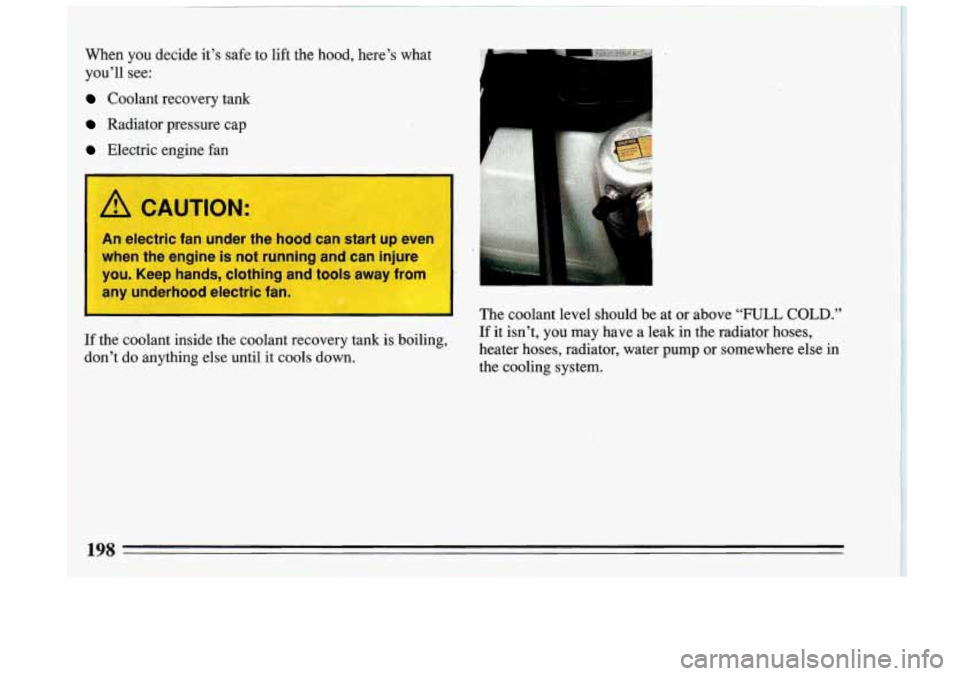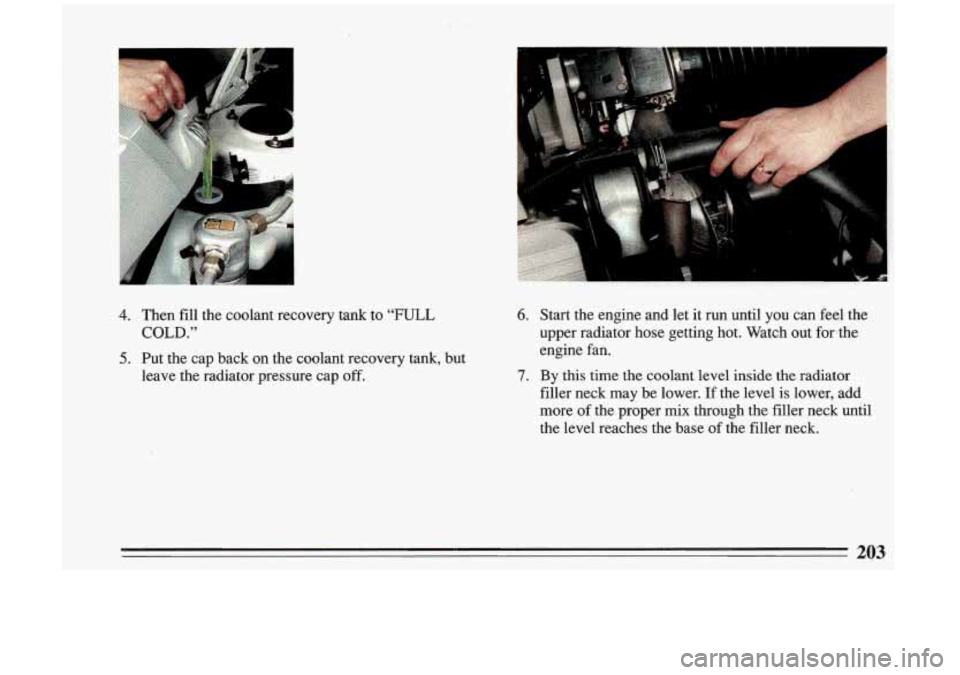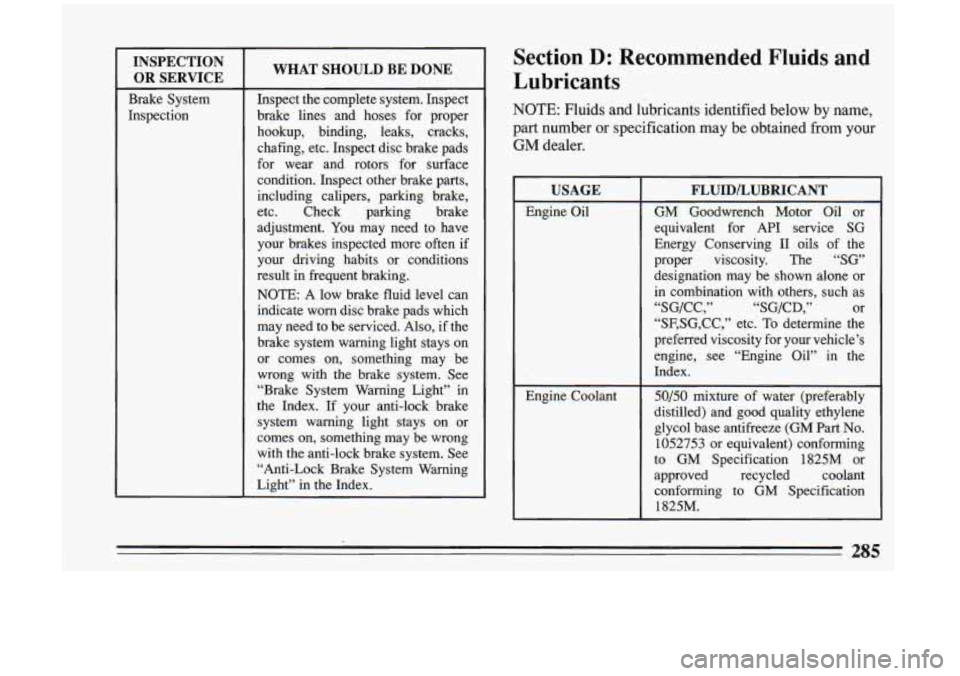1993 BUICK RIVIERA coolant level
[x] Cancel search: coolant levelPage 200 of 324

When you decide it’s safe to lift the hood, here’s what
you’ll
see:
Coolant recovery tank
Radiator pressure cap
Electric engine fan
An electric fan under the hood can start up even
when the engine is not running and can injure
you. Keep hands, clothing and tools away from
any underhood electric fan.
I
If the coolant inside the coolant recovery tank is boiling,
don’t do anything else until it coals down. The coolant level should be at or above
“FULL COLD.”
If it isn’t, you may have a leak in the radiator hoses,
heater hoses, radiator, water pump or somewhere else
in
the cooling system.
198
Page 205 of 324

1
4. Then fill the coolant recovery tank to “FULL
COLD.’3
6. Start the engine and let it run until you can feel the
upper radiator hose getting hot. Watch out forthe
-
5. Put the cap back on the coolant recovery tank, but engine fan.
filler neck may be lower. If the level is lower, add
more of the proper mix through the filler neck until
the level reaches the base of the filler neck.
leave the
radiator pressure cap
off. 7. By this time the coolant level inside the radiator
203
Page 233 of 324

are made especially for your automatic transaxle.
Damage caused by fluid other than
DEXRONs-IIE is
not covered by your new vehicle warranty.
After adding fluid, recheck the fluid level as
described under
“How to Check.”
When the correct fluid level is obtained, push the
dipstick back in all the way.
Engine Coolant
The following explains your cooling system and how to
add coolant when it is low. If you have a problem with
engine overheating, see “Engine Overheating” in the
Index.
The proper coolant for your Buick
will:
Give freezing protection down to -34’F (-37 ’ C) .
0 Give boiling protection up to 262 ’ F ( 128 ’ C) .
Protect against rust and corrosion.
Help keep the proper engine temperature.
0 Let the warning lights work as they should.
What to Use:
Use a mixture of one-half clean water (preferably
distilled) and one-half antifreeze that meets “GM Specification 1825-M,” which won’t damage aluminum
parts. Use GM Engine Coolant Supplement (sealer) with
any complete coolant change. You can also use a
recycled coolant conforming to “GM Specifications
1825-M” with a complete coolant flush and-refill.
If you
use these, you don’t need to add anything else.
Adding only plain water to your cooling system
can be dangerous. Plain water, or some other
liquid like alcohol, can boil before the proper
coolant mix will. Your vehicle’s coolant warnin!
system
is set for the proper coolant mix. With
plain water or the wrong mix, your engine coul
get
too hot but you wouldn’t get the overheat
warning. Your engine could catch fire and you
or others could be burned. Use a
50150 mix of
clean water and
a proper antifreeze.
231
Page 234 of 324

Adding Coolant
The engine coolant
recovery tank is located at
the left
of the engine
compartment.
To Check Coolant: When
your engine is cold, the
coolant level should be at
“FULL COLD,” or a little
higher. When your engine
is
warm, the level should be
up to
“FULL HOT,” or a
little higher.
To Add Coolant: If you need more coolant, add the
proper mix at the coolant recovery
tank.
232
Page 282 of 324

.Section B: Owner Checks and
Services At Each Fuel Fill
(It is important for you or a service station attendant
to perform these underhood checks at each fuel
fill.)
Listed below are owner checks and services which
should be performed at the intervals specified to help
ensure the safety, dependability and emission control
performance of your vehicle.
Be sure any necessary repairs are completed at once.
Whenever any fluids or lubricants are added to your
vehicle, make sure they are the proper ones, as shown in
Section
D.
CHECK OR
SERVICE
Engine Oil
Level
Engine Coolant
Level
Windshield
Washer Fluid
Level
WHAT TO DO
Check the engine oil level and add
the proper oil if necessary. See “Engine Oil” in the Index for further
details.
Check the engine coolant level in the
coolant recovery tank and add the
proper coolant mix if necessary. See “Coolant” in the Index for further
details.
Check the windshield washer fluid
level in the windshield washer tank
and add the proper fluid if necessary.
See “Windshield Washer Nuid”
in
the Index for further details. ~-~ ~- ~
280 .~
Page 287 of 324

INSPECTION OR SERVICE
Brake System
Inspection
WHAT SHOULD BE DONE
Inspect the complete system. Inspect
brake lines and hoses for proper
hookup, binding, leaks, cracks,
chafing, etc. Inspect disc brake pads
for wear and rotors for surface
condition. Inspect other brake parts, including calipers, parking brake,
etc. Check parking brake
adjustment. You may need to have
your brakes inspected more often if
your driving habits or conditions
result in frequent braking.
NOTE: A low brake fluid level can
indicate worn disc brake pads which
may need to be serviced. Also, if the
brake system warning light stays on
or comes on, something may be
wrong with the brake system. See
“Brake System Warning Light” in
the Index. If your anti-lock brake
system warning light stays on or
comes
-on, something may be wrong
with the anti-lock brake system. See “Anti-Lock Brake System Warning
Light” in the Index.
Section D: Recommended Fluids and
Lubricants
NOTE: Fluids and lubricants identified below by name,
part number or specification may be obtained from your
GM dealer.
USAGE
Engine Oil
Engine Coolant
FLUID/LUBRICANT
GM Goodwrench Motor Oil or
equivalent for API service SG
Energy Conserving
I1 oils of the
proper viscosity. The
“SG’
designation may be shown alone or
in combination with others, such as
“SG/CC,” “SG/CD,” or
“SF,SG,CC,” etc. To determine the
preferred viscosity for your vehicle’s
engine, see “Engine Oil” in the
Index.
50/50 mixture of water (preferably
distilled) and good quality ethylene
glycol base antifreeze
(GM Part No.
1052753 or equivalent) conforming
to GM Specification 1825M
or
approved recycled coolant
conforming to GM Specification
1825M.
285
Page 304 of 324

High Speed. Shifting When Your Engine is Running ..... 76 Jack. Tire ..................................... 205
Highway Hypnosis
............................... 172 Jacking Up the Car ............................... 205
Hill and Mountain Roads
.......................... 173 Jump Starting ................................... 186
Hills. Parking on
................................. 175
Holding a Baby in Your Car
......................... 43
Hood. Opening the
............................... 221
Horn ........................................... 84 Keys 59
Hot Coolant Warning Light
........................ 113 Keyless Entry System. Remote 64
Hydroplaning
................................... 166
..........................................
......................
Hot Engine. Safety Warnings About 196 Kilomefa- J&$q$cx .. +... .? . ... _. % ......... . ... .’_ rs.z7 t- ........ . 105 .................
Ice. Driving on ................................. 179
Identification Label. Service Parts
................... 261
Identification Number. Vehicle
..................... 261
Idling Your Engine
................................ 82
If You’re Stuck: In Sand. Mud. Ice or Snow
........... 214
Indicator. Turn Signal
............................. 85
Indicators. Disc Brake Wear ....................... 156
Indicators. Warning Lights and Gages
................ 107
Infant Restraint
................................... 45
Inflation. Tire
................................... 245
Inside Mirror
.................................... 99
Inspection. Tire
................................. 245
Instrument Panel
................................ 105
Interior Cleaning
................................ 253
Interlock. Brake-Transaxle Shift
.................. 75. 81
Introduction
. How To Use This Manual ............... 10
Ignition Key Positions
............................. 71
Label.
Service Parts Identification
.................. 261
Lane Change Indicator
............................. 85
Lap-Shoulder Belt Usage by Children
................. 55
Leaving Your Vehicle .............................. 80
Level Control. Electronic
.......................... 104
License Plate Holder. Rear
......................... 104
Light. Safety Belt
................................. -25
Light.
Turn Signal Indicator ......................... 85
Lighter. Cigarette
................................ 111
Lights Daytime Running
.............................. 98
Panel and Interior
.............................. 96
Traffic
...................................... 145
“On” Warning
................................. 96
Operation
.................................... 86
Loading Your Vehicle ............................ 242
Lap Belt
........................................ -42
Lights
& Gages. Warning Indicators ................. 107
302